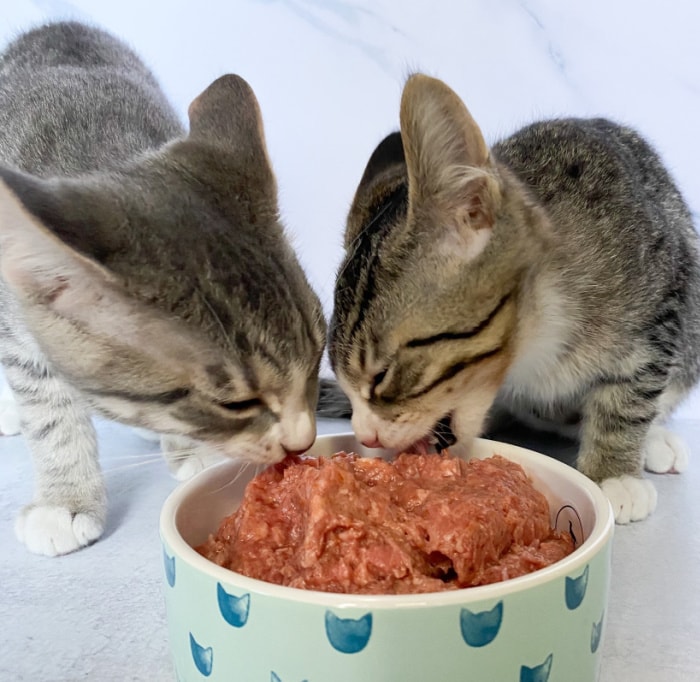Published by: Ingrid King. Last Updated on: February 6, 2023 by Crystal Uys

This post is sponsored by Darwin’s Natural Pet Products*
Embraced for decades by holistically oriented pet parents and holistic veterinarians, raw feeding is becoming more and more mainstream as cat parents look for alternatives to feeding highly processed commercial pet foods. I’ve been feeding raw for the past ten years, and have seen my cats thrive on it. For the past five years, I’ve been feeding Darwin’s, and it has become a perennial favorite.
Feeding your cat a species-appropriate diet is the most important thing you can do for her lifelong health. You can’t control your cat’s genetics, but you can control what you feed her. And even though cat food manufacturers would have you believe differently, a cat’s diet needs don’t change all that much over the course of her life.
Life stages explained
So-called life stages diets come for kittens, young adults, mature adults, and seniors. There is no single definition for what age range each life stage actually includes. Generally, cats are considered kittens until they’re about 6 months old, young adults from seven month to two years, mature adults between three and 10 years. Cats over 10 are considered senior, and cats over 15 are considered geriatric.
Only two life stages really matter
When it comes to a cat’s nutritional needs, there are really only two life stages that matter: kitten and adult. In the wild, kittens will nurse from their mother for the first three to four months of their lives. After that, the mother will gradually introduce her kittens to solid food by teaching them to hunt. The prey they learn to catch is what cats in the wild will eat for the rest of their lives.
Nutritional needs of kittens
Kittens do need more protein and calories per pound of body weight than an adult cat, but they get this by eating more frequent meals, not by eating a special “kitten food.” Kittens should eat as much food as they want in three or four meals a day until they’re four to six months old. Since a kitten’s nutritional requirements vary even more than an adult cat’s, a kitten’s weight and body condition should be monitored closely so feeding amounts and frequency can be adjuste accordingly.
Senior cats
Senior cats require more energy to maintain their body weight, in part because their fat and protein digestion is impaired. To compensate for impaired nutrient absorption, senior cats need to eat more food with sufficient protein levels relative to their body weight than younger cats. Dietary protein supplies amino acids and is needed for the manufacture of antibodies, enzymes, hormones, and tissues. It provides energy and is essential for growth and development. Protein derived from meat and poultry contains ample amounts of these essential amino acids. While vegetable and grain based proteins provide amino acids, cats, unlike dogs and other omnivores, lack the enzymes required to process them metabolically.
For many years, pet food companies marketing lifestages and lifestyle diets for senior cats have mistakenly led us to believe that senior cats require less protein. This couldn’t be more wrong: a lack of protein in a senior cat diet can lead to muscle wasting. A raw diet is an excellent way to provide sufficient protein for senior cats.
Darwin’s Natural Pet Food is appropriate for all life stages
Holistic veterinarian Dr. Andrea Tasi of Just Cats Naturally has been feeding raw to her now 12-year-old cat raw Polly was a kitten. “I started her on raw food as soon as she was eating on her own,” says Dr. Tasi. “Kittens in nature would be brought prey by their moms, “who (I’m pretty sure) would not have cooked it first!” Dr. Tasi acknowledges that the potential risk of food borne disease is far lower in prey than in commercial raw food, “so I’m not saying it’s completely risk free. Bottom line: if I trust the safety/quality of the food, I’m okay with raw food for kittens.”
Darwin’s recommends gently cooking their food for kittens. “We recommend lightly sautéing our food over medium to medium-high heat for 8-12 minutes to minimize any risks associated with feeding raw foods to puppies and kittens. For cats over 4 months with fully developed immune systems, no cooking is required.”
About Darwin’s
As far as I’m concerned, Darwin’s is doing everything right, both in terms of what’s in the food and what’s not:
-
- 100% meat – no animal-by-products or fillers
- Ethically sourced human grade ingredients from farms they trust
- Formulated under the guidance of veterinary nutritionists
- Free range, pasture raised, cage-free meats
- No. GMO
- No steroids
- No hormones
- Made fresh: you will receive your meals 4-6 weeks from production
For more information and to order, please visit DarwinsPet.com.
Special offer: get 10 pounds for $14.95!
Darwin’s has an introductory offer that can’t be beat so you can try this for your own cats: For $14.95, you get 10 pounds of raw food. You can customize the flavors depending on your cat’s taste preferences.
Once you place your introductory order, you are automatically set up for automatic shipments (you choose the frequency of shipment,) but you can cancel or change this at any time.
*FTC Disclosure: This is a sponsored post, which means that I was compensated to feature this content. Regardless of payment received, you will only see products or services featured on this site that we’ve either used or would use ourselves. The Conscious Cat is a participant in Darwin’s affiliate program. This means that if you decide to purchase through any of our links, we get a small commission.
Photo via Darwin’s Facebook page, used with permission
Ingrid King is an award-winning author, former veterinary hospital manager, and veterinary journalist who is passionate about cats.
